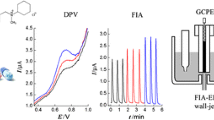Abstract
Factors influencing the accuracy of water determinations using diaphragm-free, pulsed current Karl Fischer (KF) coulometry were investigated with the new Metrohm 756 instrument. Results obtained with commercially available reagents from Riedel-deHaën and Merck were compared with home-made ones that were especially designed to minimize the formation of iodine-consuming reduction products generated in the cathode reaction. Positive errors in the range 2–5% were found for the commercial reagents as compared to 0.2–1% for the home-made ones which were buffered at about pH 10 containing modifiers like chloroform, hexanol or ethylene glycol. Except for the composition of the KF-reagent, the cathode current density and the titration rate were found to be critical parameters for the accuracy of the determinations. For all reagents investigated, the best results were obtained for the maximum generator current 400 mA (corresponding to a current density of 1400 mA cm–2) in combination with a maximum titration rate of 2000 μg min–1. Surprisingly, the errors found under optimum conditions for the pulse technique were always somewhat larger than the corresponding values obtained with continuous coulometry.
Similar content being viewed by others
Author information
Authors and Affiliations
Additional information
Received: 15 December 1999 / Revised: 21 February 2000 / Accepted: 26 February 2000
Rights and permissions
About this article
Cite this article
Nordmark, U., Cedergren, A. Progress in pulsed-current Karl Fischer coulometry using diaphragm-free cells. Fresenius J Anal Chem 367, 519–524 (2000). https://doi.org/10.1007/s002160000382
Issue Date:
DOI: https://doi.org/10.1007/s002160000382




